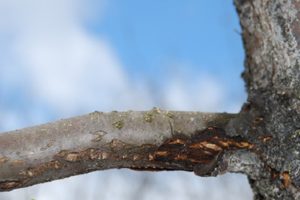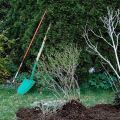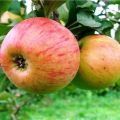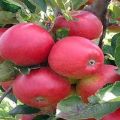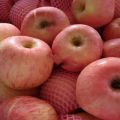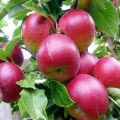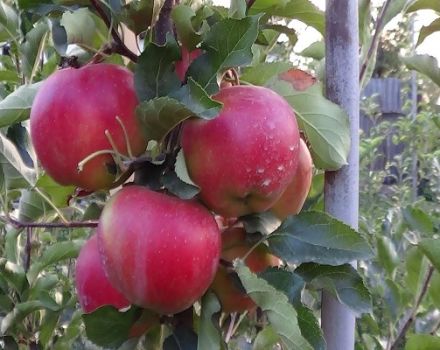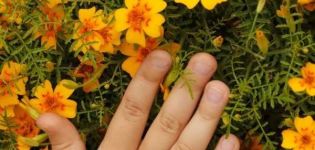What varieties of apple trees on a dwarf rootstock are suitable for growing in a summer cottage
Breeders are constantly developing new varieties of apple trees that differ in taste, size and other characteristics. Many gardeners grow dwarf apple trees in their summer cottages, which bear juicy fruits and can perform a decorative function. Despite their compact size, fruit trees are not inferior in quality to larger varieties.
Content
- 1 Features and benefits of the view
- 2 Main disadvantages
- 3 What is the difference from ordinary apple trees
- 4 Varieties of varieties
- 5 How to plant trees
- 6 Growing apple trees on dwarf rootstocks
- 7 Rules for caring for dwarf apple trees
- 8 Features of crown formation
- 9 Diseases and pests, ways to combat them
Features and benefits of the view
The category of low-growing trees has a small crown and grows to a height of no more than 3 m. The thin trunk of apple trees is reliable and withstands a lot of abundantly ripening fruits... Subject to proper planting and further care, the trees bring crops in 2-3 years. The advantages of dwarf plants include the following:

- Due to their low height, the trees are easy to handle and harvest. Gardeners who care for dwarf apple trees do not spend much time on basic agricultural techniques.
- It is allowed to grow trees every 1-1.5 meters. A dense planting significantly increases the yield in comparison with the classic varieties of trees.
- In strong wind and precipitation, a small amount of fruit falls to the ground. Even when apples fall, they are not damaged due to the small height of the trees.
- The root systems of dwarf varieties react faster to fertilization and irrigation, due to which the crop ripens earlier.
- Due to the peculiarities of the structure, undersized plantings receive more natural light, and more vitamin C and sugars accumulate inside the fruit.
- The process of development and ripening of the crop stops several weeks earlier than that of standard varieties, which allows harvesting before the first frost.
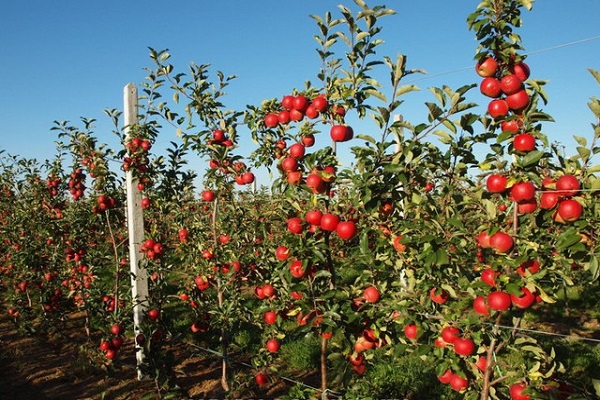
Main disadvantages
Besides a number of comparative advantages, undersized apple trees have several negative characteristics. The main disadvantage is poor cold tolerance, which is why plantings on dwarf rootstocks can freeze out at low temperatures. In addition, this variety requires regular and careful maintenance in order to obtain a large harvest. The list of disadvantages also includes:
- deep digging of soil when caring for plantings can damage the root system, since it lies in the upper soil layers;
- a tree of small height is more fragile, therefore, when planting seedlings, it is required to build supports;
- fruits of dwarf varieties attract a large number of pests, therefore, antiparasitic treatment is required to grow a high-quality crop.
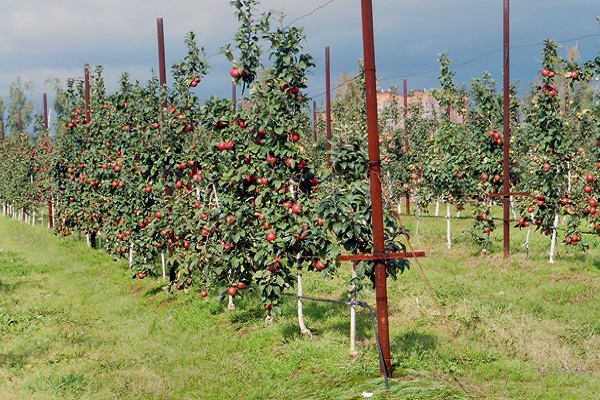
What is the difference from ordinary apple trees
Inexperienced gardeners, when planting seedlings, often confuse undersized varieties with ordinary and columnar ones. Dwarf varieties are distinguished by a spreading crown, which reaches 3 m in diameter. Common species have a crown of one trunk, with great branching.
Columnar trees outwardly resemble an elongated trunk, on top of which fruits grow.
To distinguish dwarf apple seedlings, it is necessary to pay attention to the root system and trunk when choosing. In undersized seedlings, the trunks have branches that appear in the early stages of growth. The root system has a fibrous structure, and its firmness and elasticity testify to the high quality of the seedling, due to which the apples bear abundant fruit. In standard varieties, the roots are taproots.
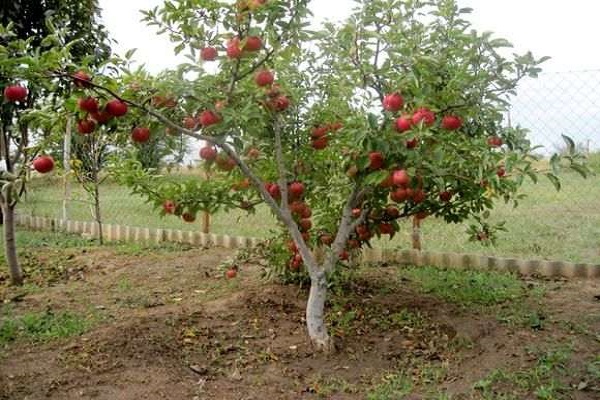
Varieties of varieties
There is a large variety of dwarf apple trees. Trees of different species differ from each other by the duration of ripening, the characteristics of growth in certain regions, the size of the fruits. In order to choose the best option for disembarking at your summer cottage, it is important to familiarize yourself with the characteristics of each species.
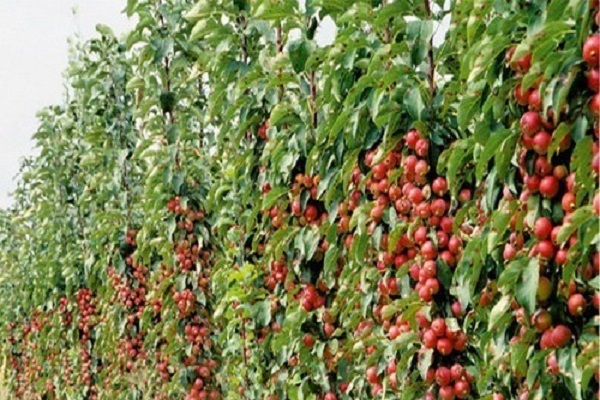
By maturity
Depending on the period when the trees begin to bear fruit, early-, mid- and late-ripening varieties are distinguished. Early ripening ripens at the end of July. One of the most common varieties is Melba, which bears juicy fruits weighing more than 100 g. Also known are the Candy and Chudny varieties, which produce fruits weighing 120 and 150 g, respectively.
Summer varieties are distinguished by pronounced taste characteristics, and their fruiting begins from the 3-4th year of vegetation.
Among the mid-ripening varieties, the Zhigulevsky variety was in great demand, which easily tolerates low temperatures and yields a harvest at the end of September. The weight of one fruit reaches 200 g. The crop can be stored throughout the winter without loss of taste.
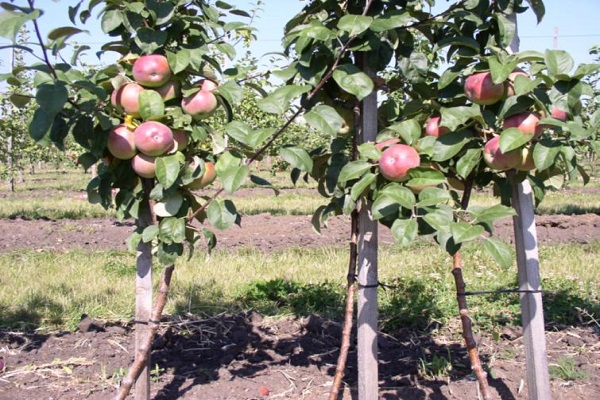
Among the late-ripening varieties, the Bratchud and Bogatyr species can be distinguished. These varieties begin to bear fruit from the 4th-5th year, they are resistant to frost and stable yield. The fruits of the trees are sweet and juicy when properly cared for.
By zoning
To obtain a large harvest, it is necessary to grow a variety suitable for a particular region. Climatic conditions differ in different regions, so some varieties may not take root. For example, the soil and temperature in the Moscow region belong to the middle lane, and apple trees grafted onto clonal undersized rootstocks are in demand here. Experienced gardeners plant varieties Melba, Zhigulevsky and Grushevka near Moscow in the middle zone.

Clonal rootstocks should not be grown in Siberia, as they freeze out under the influence of low temperatures. The varieties Palmetta, Nezhenka, and Siberian souvenir are resistant to Siberian cold. These varieties bring a good harvest when planted in a 2.5 x 2 m pattern.
In Nizhny Novgorod, as well as in the Moscow region, the Zhigulevsky variety takes root well, which is appreciated not only for its early ripening, but also for its resistance to an unfavorable climate. This variety of apple is practically not exposed to scab and undergoes conditions of high humidity.
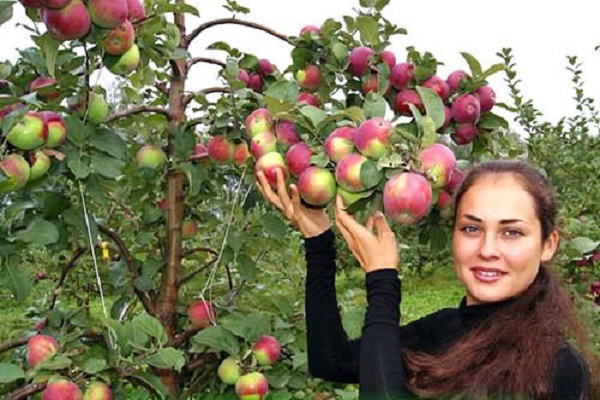
How to plant trees
Dwarf trees can be propagated in several ways. The easiest way to do this is by budding. The procedure is carried out in early spring, when the first leaves begin to grow. The essence budding apple trees consists in the fact that a bud with adjoining tissues is cut out of a one-year scion shoot, which is inserted into an incision on the rootstock trunk.
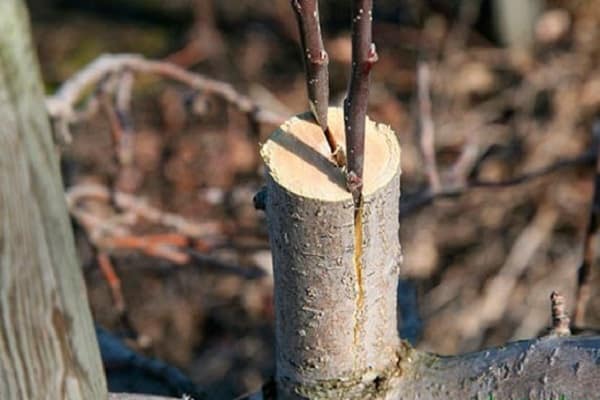
Growing apple trees on dwarf rootstocks
When planting trees on dwarf rootstocks, a number of points must be considered. First of all, the site of grafting at the seedling should be located above the surface of the soil, since otherwise the plants will begin to grow actively prematurely. It is recommended to distribute the roots of the seedling evenly around the trunk, avoiding bending upward.
It is better to plant apple trees on stocks in spring, before the onset of a stable hot temperature. Planting seedlings requires the mandatory construction of supports that will help the plant not to bend over in strong winds and the ripening of heavy fruits.
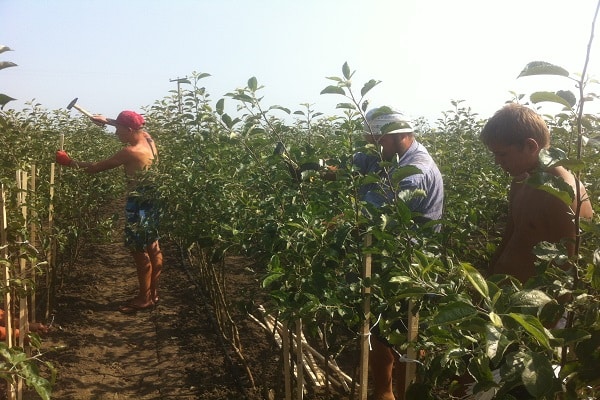
Rules for caring for dwarf apple trees
The process of caring for seedlings involves the regular implementation of basic actions - watering, loosening, plowing, feeding and protecting against pests. To grow healthy trees, follow these guidelines:
- Regularly inspect the plantings in order to timely detect signs of disease and the presence of pests.
- When plowing and loosening the earth, be careful, since the root system of the seedlings is at a shallow depth.
- Before planting, prepare a place for the location of the seedling, making sure of the quality of the soil and the absence of blowing through winds.
It is also important to consider the time of year when caring for apple trees. Depending on the temperature conditions, there are certain nuances in the processing of seedlings.

Summer
When leaving in the summer, special attention should be paid to watering. The soil around the trunk must always be kept moist and not dry out. In hot weather, the activity of pests increases, and special chemicals should be used to scare them away.
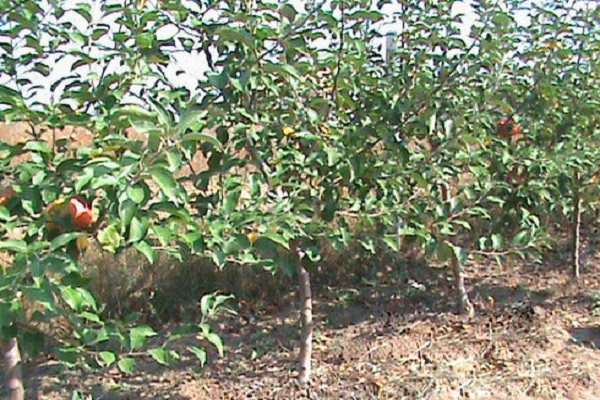
In autumn
In the autumn, most of the dwarf varieties ripen. By the time of harvesting, the tree trunk must be constantly cleared of falling leaves, fruits and weeds. When the area around the trunk is cleared of plant debris, you need to loosen the ground to remove lumps and break the thermal insulation of pests living in the ground.
By mid-autumn, disinfection treatment should be carried out to prevent the appearance of new harmful insects.
After harvesting, it is necessary to apply top dressing using fertilizer with a high content of mineral components. After this, a sanitary apple pruning in order to remove dried leaves and eliminate thickened planting.
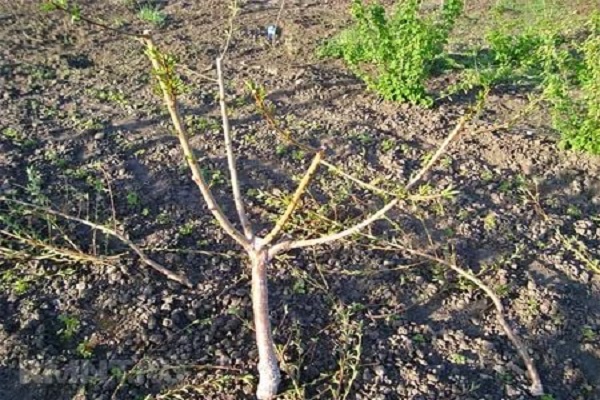
In winter
Caring for fruitful trees during the winter is a prerequisite for a good harvest next season. With the onset of frost, it is necessary to regularly monitor the condition of the heaters that cover the roots and the lower part of the apple tree trunk. During winter, hares or mice can gnaw the covering material. There is also a risk of damage to the insulation due to the abundant accumulation of snow.
To prevent tree crowns from breaking, you need to constantly monitor the amount of snow on the surface. If a thick layer of snow forms on the branches, shake it off. Otherwise, after the onset of heat, the snow will melt, and under its mass the fragile branches will break.
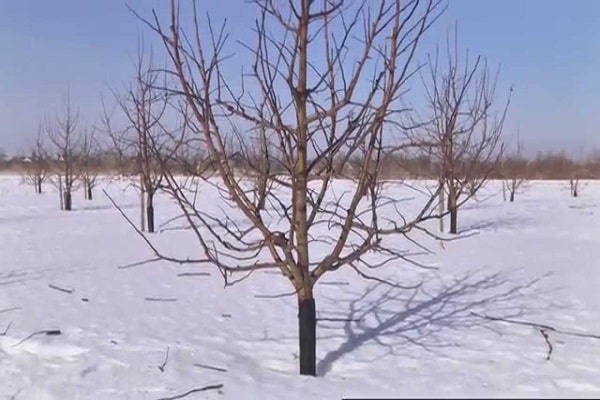
In the spring
In early spring, new seedlings need to be pruned for further active growth. If the tree has been growing for several seasons, then pruning is required in the spring for shaping and for sanitary purposes. One of the important stages of spring care is the treatment of diseases and harmful insects. It is also recommended to attach trapping belts to the trunks of dwarf apple trees to catch pests.
After the snow melts, you need to start making sure that the soil surface around the trunk does not dry out. Each watering should be completed by loosening the soil not 50-70 mm deep.Mulching can be done around the trunk to reduce watering frequency and keep moisture in the ground. In early April, during clear weather, you need to whitewash the lower part of the trunk. It is also required to apply top dressing using complex or nitrogen fertilizer.
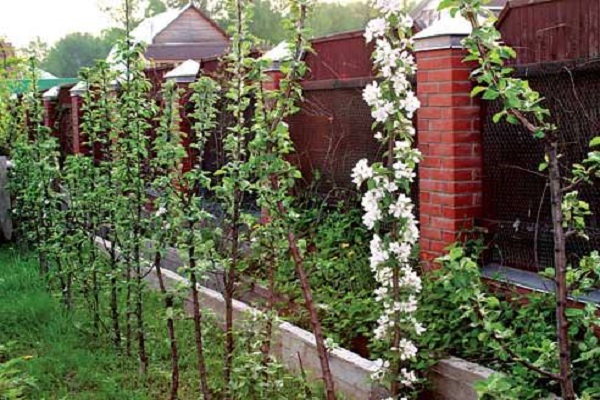
Features of crown formation
Crown pruning of apple trees is performed twice a year to shape... The crown should be pruned in spring and autumn, when new shoots have not entered the phase of intensive growth. To increase the volume of the crown, young shoots should be directed outward. This will help make the tree more compact in appearance, while the branches will not stick out in different directions.
Most often, the need for pruning the crown arises when planting in a summer cottage with a small free space in the garden.
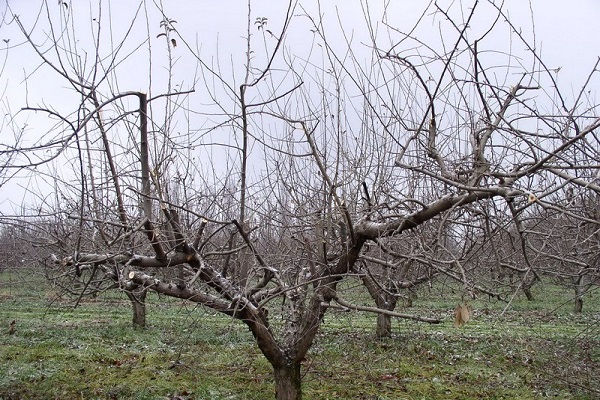
Diseases and pests, ways to combat them
Apple trees grown on a dwarf rootstock are subject to the same diseases as the classic varieties. With improper care, negative external influences or constant cloudy weather, there is a high probability of the appearance of diseases such as powdery mildew, scab, mosaic, rot, cytosporosis. In order to timely track the appearance of the disease, it is necessary to regularly inspect the seedlings and, if the first signs of infection are found, proceed with fungicidal treatment.
A solution of copper sulfate, colloidal sulfur and Bordeaux liquid are suitable for combating diseases.
Among pests, caterpillars and butterflies are considered dangerous for the fruits of dwarf apple trees. Insects gnaw through the fruits and leaves of trees, which leads to a reduction in the quantity and quality of the crop. To scare off pests, it is necessary to spray the vegetation with special preparations.

